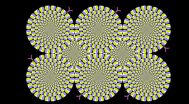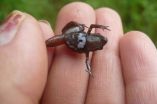Study finds association between blood levels of trace metals and risk of glaucoma
2015-08-06
(Press-News.org) In an analysis that included a representative sample of the South Korean population, a lower blood manganese level and higher blood mercury level were associated with greater odds of a glaucoma diagnosis, according to a study published online by JAMA Ophthalmology.
Glaucoma is the leading cause of irreversible blindness worldwide and a growing public health concern because of an aging global population. Abnormal body levels of essential elements and exposure to toxic trace metals have been postulated to contribute to the pathogenesis of diseases affecting many organ systems, including the eye, according to background information in the article.
Shan C. Lin, M.D., of the University of California, San Francisco, and colleagues investigated the relationship between body levels of 5 trace metals (manganese, mercury, lead, cadmium, and arsenic) and the prevalence of glaucoma. Blood or urine metallic element levels and information pertaining to ocular disease were available for 2,680 individuals (19 years and older) participating in the fourth Korea National Health and Nutrition Examination Survey between January 2008 and December 2009, the second and the third years of the survey (2007-2009).
After adjustment for potential confounders, analyses indicated that lower blood manganese levels and higher blood mercury levels were associated with greater glaucoma prevalence. No association was found between blood lead or cadmium levels or urine arsenic levels and a diagnosis of glaucoma in the study population.
"Future prospective investigations will be necessary to confirm these associations and to explore the role of trace elements in the pathogenesis of glaucoma, as well as possible neuroprotective effects, which could lead to novel therapeutic targets in glaucoma management," the authors write.
INFORMATION:
(JAMA Ophthalmol. Published online August 6, 2015. doi:10.1001/jamaopthalmol.2015.1440. Available pre-embargo to the media at http://media.jamanetwork.com.)
Editor's Note: This study was supported by a core grant from the National Eye Institute, by That Man May See, and by Research to Prevent Blindness. All authors have completed and submitted the ICMJE Form for Disclosure of Potential Conflicts of Interest and none were reported.
Media Advisory: To contact Shan C. Lin, M.D., call Scott Maier at 415-476-3595 or email Scott.Maier@ucsf.edu.
ELSE PRESS RELEASES FROM THIS DATE:
2015-08-06
WASHINGTON, Aug. 6, 2015 -- Optical illusions are deceptive and mind-boggling. What's going on inside our heads when we see things that appear to be moving but aren't, and when we view other, similar visual tricks? In this collaboration between the American Chemical Society and Inside Science TV, we explain how optical illusions work, so you can understand the science behind the trickery. Check it out here: https://www.youtube.com/watch?v=VYIr40D7wNw.
Inside Science TV is a production of the American Institute of Physics. See more videos in the series on the ISTV YouTube ...
2015-08-06
Enhancement of the Petawatt laser "LFEX" [1] up to 2,000 trillion watts for one trillionth of one second.
High power output implemented by a 4-beam amplifier technology and the world's highest performance dielectric multilayer diffraction grating of large diameter [2].
Big step forward for creating such new fundamental technologies as cancer therapy for medical applications and non-destructive inspection of bridges and buildings, to contribute to our future life of longevity, safety, and security, and for the realization of fast ignition as an energy resource.
The ...
2015-08-06
The results of their research have recently been published in the high-profile journal eLife*.
The ability of most cardiac muscle cells to reproduce disappears in humans and all other mammals shortly after birth. What remains unclear, however, is how this happens and whether it is possible to restore this ability and therefore to regenerate the heart.
FAU researchers Dr. David Zebrowski and Prof. Dr. Felix B. Engel from the Department of Nephropathology at Universitätsklinikum Erlangen's Institute of Pathology and their colleagues have now found a possible explanation ...
2015-08-06
Carrying itself around with a dark brown mask on its face and a broad shapeless white mark on its chest and belly, a frog had been jumping across the Peruvian cloud forests of the Andes unrecognised by the scientific world. Now, this visibly distinguishable species has been picked up by Dr. Catenazzi of Southern Illinois University and his team from its likely only locality, a cloud forest near Cusco in Peru, at 2350 m elevation by Drs. Catenazzi, Uscapi and May. Their research is published in the open-access journal ZooKeys.
The new fleshbelly frog species, called N. ...
2015-08-06
Researchers from the International Research Institute of Disaster Science (IRIDeS) at Tohoku University in Sendai, Japan, have been looking into how tsunami-type waves can originate from massive storm systems, independent of earthquakes or landslides.
According to Volker Roeber and Jeremy D. Bricker, massive storm systems can be the cause of devastating tsunami-type waves. It happened during Typhoon Haiyan, which struck the Philippines in November 2013. Typhoon Haiyan was one of the strongest typhoons ever recorded, causing more than 6,000 casualties.
A development ...
2015-08-06
People who recognise they are overweight or obese are more likely to put on weight than those who are unaware that they may be heavier than doctors would advise, according to research by the University of Liverpool.
In a study, published in the International Journal of Obesity, researchers looked at the lives of 14,000 adults in the US and the UK through data captured in three studies: the US National Longitudinal Study of Adolescent to Adult Health, the UK National Child Development Study and Midlife in the United States.
They analysed data from time periods after ...
2015-08-06
Lack of microinvaginations in the cell membrane, caveolae, can cause serious diseases such as lipodystrophy and muscular dystrophy. Researchers at Lund University in Sweden have now discovered a "main switch" that regulates the formation of these invaginations.
Many cells in the body are equipped with small microinvaginations in the cell membrane called caveolae. They are important for the cell's ability to take up molecules and particles from the cell surface into the cell. If this doesn't work, the function of the cell is disturbed, resulting in diseases. Having too ...
2015-08-06
New camera technology that reveals the world through the eyes of animals has been developed by University of Exeter researchers. The details are published today in the journal Methods in Ecology and Evolution.
The software, which converts digital photos to animal vision, can be used to analyse colours and patterns and is particularly useful for the study of animal and plant signalling, camouflage and animal predation, but could also prove useful for anyone wanting to measure colours accurately and objectively.
The software has already been used by the Sensory Ecology ...
2015-08-06
Dasabuvir (trade name Exviera) and the fixed-dose drug combination ombitasvir/paritaprevir/ritonavir (trade name Viekirax) have been available since January 2015 for the treatment of adults with chronic hepatitis C infection. The German Institute for Quality and Efficiency in Health Care (IQWiG) had examined their added benefit in a dossier assessment completed in April 2015.
In an addendum, the Institute now assessed study data subsequently submitted by the drug manufacturer in the commenting procedure. According to the findings, the results of an indirect comparison ...
2015-08-06
Why some planets, like Saturn or Jupiter, have their rings, while others like, the Earth or Mars do not? It turned out that "the size does not matter" -- not only giants as Saturn possess the rings, but even tiny asteroids do: According to the recent discovery of the Spitzer Space Telescope, the remote asteroid Chariklo, which is only 260 km in diameter, also has rings.
A natural answer may be the following: Occasionally, in a far past, some planets had much more material in their vicinity then the other ones. The material was in a form of dust. Dust particles merged ...
LAST 30 PRESS RELEASES:
[Press-News.org] Study finds association between blood levels of trace metals and risk of glaucoma





